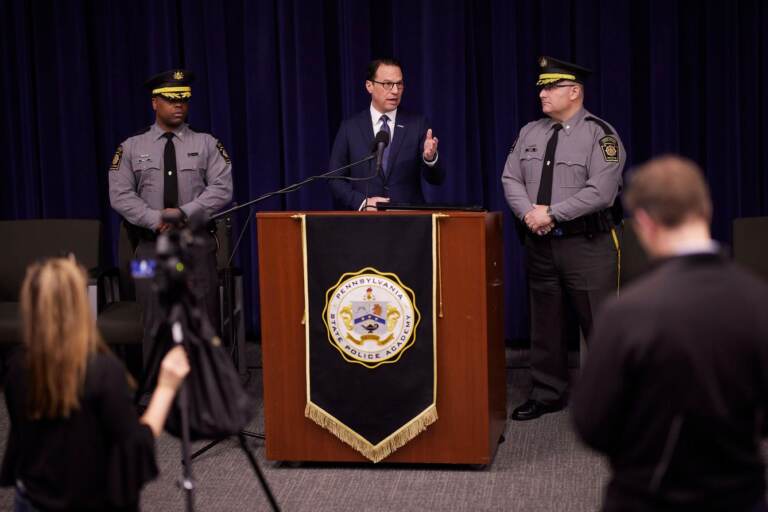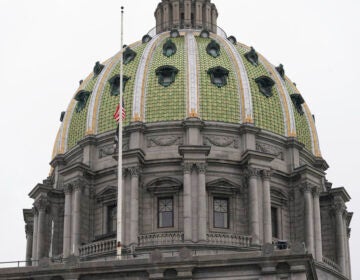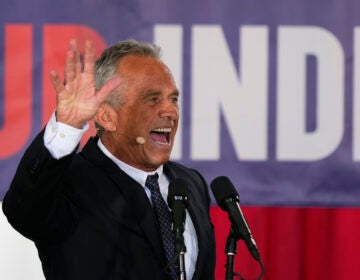Shapiro’s proposed Pa. State Police fund saves road dollars but raises accountability concerns
Shapiro would end those transfers by creating a new restricted bank account for State Police.

(Commonwealth Media Services)
This story originally appeared on Spotlight PA.
In his first budget proposal as governor, Democrat Josh Shapiro aims to resolve a longstanding fiscal conundrum: funding the Pennsylvania State Police without taking money away from bridge and road repairs.
At the moment, $900 million of the agency’s roughly $1.4 billion budget comes from the state’s General Fund, while the rest comes from the state’s Motor License Fund, which receives money from the state’s gas tax and is primarily meant to be used for infrastructure spending.
Shapiro would end those transfers by creating a new restricted bank account for State Police. Unlike the General Fund — the state’s main account, which can use the billions of dollars it receives from sales and income tax payments each year for any purpose — this new police account wouldn’t be subject to annual budget negotiations between the governor and legislature.
Instead, by law, a set amount of tax revenue would automatically be allocated to it each year without debate.
“The pledge I’ve made to our state troopers is that that money would be set aside and walled off only for law enforcement, meaning it couldn’t be used for any other purpose,” Shapiro said recently in Erie. “We’ve got to make sure those dollars first go to meeting our law enforcement needs.”
Shapiro’s plan has the support of legislative Democrats, who see another possible upside: Creating such an account would mean the legislature and Shapiro would need to pass a law, which could also include provisions like a long-sought requirement for state and local police to collect racial data from traffic stops. As Spotlight PA previously reported, State Police stopped collecting such data for nearly a decade, leaving observers unable to check for racial bias.
State Rep. Donna Bullock (D., Philadelphia), chair of the Legislative Black Caucus, said such a requirement, crafted in partnership with State Police, is an option.
“We’ve seen more progress when we’ve worked together as opposed to using threats of the purse,” Bullock said.
But some GOP lawmakers have criticized the effort to create a State Police fund, arguing this style of “autopilot” budgeting makes state finances less flexible and more opaque.
A so-called special fund like the one Shapiro is proposing is far from a novel idea. Past legislatures have created more than 150 similar accounts, which are financed through taxes, fines, or fees. That money is then channeled to specific uses, such as providing grants to drain mine runoff or funding operating budgets for state regulatory agencies.
On average, these funds account for about three in every 10 state dollars spent every year. Last year, they amounted to more than $20 billion.
Shapiro and the plan’s supporters, including the state troopers union, argue that a dedicated revenue stream will keep State Police funding stable. Policy analysts have noted that the certainty of such funding models has drawn states to increasingly turn to dedicated funds to pay for public programs.
A 2019 report by the Urban Institute, a Washington, D.C.-based think tank, looked at six states’ budgeting and found that the amount of restricted state spending increased from 2000 to 2015.
The report also noted one of the biggest drawbacks to this budgeting technique: It essentially privileges restricted funds over other spending priorities.
“Considered in isolation, each tax or spending restriction may have some merit by locking in important commitments,” the report said. “But together, they create a block of preexisting priorities against which residual options, those that lack such protections, must compete.”
GOP legislators have echoed this concern, arguing the use of restricted funds allows for less legislative oversight year over year while reducing the amount of flexible money lawmakers have to set their priorities.
“At what point do we just say, ‘All right, we’re done appropriating … We’ll just put it all on autopilot. Human services get 40% of the budget, education gets 40% of the budget, the rest of you fight over the 20%,’” state Rep. Seth Grove (R., York), the ranking Republican of his chamber’s Appropriations Committee, said during a news briefing in March. “And I don’t think that’s the trajectory we want to go.”
Pennsylvania has used its gas tax to fund State Police for decades. But a big gas tax hike in 2013 — approved by former Republican Gov. Tom Corbett as a way to increase funding for repairs to the state’s crumbling infrastructure — spotlighted those growing transfers as a barrier to the commonwealth catching up on decades of deferred maintenance.
The General Assembly placed a cap on the amount of Motor License Fund money that can be used annually to fund State Police in 2016, aiming to get it to $500 million by 2026. While the legislature has hit that number, it has struggled to further cut the transfers despite proposals from lawmakers in both major parties.
Shapiro’s predecessor, Democratic Gov. Tom Wolf, wanted to free up the road and bridge money by replacing it with a fee on every municipality that didn’t have its own police department and relied solely on State Police.
However, Republicans, who then controlled both chambers of the General Assembly, repeatedly rejected that plan, arguing it forced rural townships and boroughs to effectively be taxed twice for State Police coverage.
The General Assembly is now split between the Democratic-controlled state House and the Republican-controlled state Senate. Despite holding a little more legislative leverage, Shapiro took a different tack in his March budget address.
Shapiro’s proposed budget would wind down Motor License Fund transfers over the next five years, preserving $1.5 billion in gas tax revenue for road and bridge repairs over the course of that period.
But it also would require some clever accounting and new revenue from a yet-to-be-determined source.
This year, his plan asks the General Assembly to transfer about $1 billion in existing sales tax revenue on vehicles; liquor; e-cigarettes, and other tobacco products; and $400 million from the Motor License Fund into the new special restricted account, known as the Public Safety and Protection Fund.
Going forward, transfers from the Motor License Fund would continue to decrease until they reach zero by the 2027-28 fiscal year. The Shapiro administration hasn’t specified how it would replace that money, instead saying the source is up for negotiation during budget talks.
Shapiro’s budget includes a proposed 20% tax on recreational marijuana, with sales starting Jan. 1, 2025, and revenues heading to the General Fund.
At least one bipartisan marijuana legalization proposal has suggested using cannabis tax revenue to fund law enforcement. A Shapiro spokesperson did not respond to a request for comment on marijuana revenues.
Richard Auxier, a tax policy analyst at the Urban Institute, told Spotlight PA that dedicated funding streams like the proposed State Police one are often seen by policymakers as a way to build consensus on tricky topics.
For instance, Auxier said, it’s common to see tax revenue from cannabis, gambling, or cigarettes routed to a more politically popular topic like education.
But once a dedicated funding stream is created, Auxier said, “You are no longer just making a policy decision about your cigarette tax, about your cannabis tax, about your gambling policies. You’re making decisions about all the programs you’ve tied to them when you go to make those changes.”
And while dedicated funding is often meant to simplify the politics of a policy choice, sometimes that can backfire, Auxier said. For instance, if a tax funding policing has poorer-than-expected returns in any given year, the agency will be underfunded, forcing a tough decision on lawmakers: allow public safety to be low on cash or shift money from another program to cover the budget gap.
Regardless of the funding source, state House Appropriations Committee Chair Jordan Harris (D., Philadelphia) said it is necessary to free up state dollars to chase matching federal funding approved in the 2021 infrastructure law.
The law earmarked billions for infrastructure projects, but to apply for those dollars, state and local governments must cover at least 20% of project costs in most cases.
“In cities like mine, in Philadelphia and other places across the commonwealth, there are roads and bridges that need work,” Harris told Spotlight PA. “Imagine us leaving — and imagine the citizens knowing — that we left or could possibly leave hundreds of millions of dollars, if not more, in federal resources on the table.”
He also argued it would bring “predictability” to State Police funding, something that the Pennsylvania State Police Troopers Association, the labor union that represents the state’s 4,400 troopers, also supports.
“There are always concerns when projecting revenues over the long term, but we’re confident this governor will deliver on his bold plan to strengthen the Pennsylvania State Police,” the association said in a statement.
 Spotlight PA is an independent, non-partisan newsroom powered by The Philadelphia Inquirer in partnership with PennLive/The Patriot-News, TribLIVE/Pittsburgh Tribune-Review, and WITF Public Media.
Spotlight PA is an independent, non-partisan newsroom powered by The Philadelphia Inquirer in partnership with PennLive/The Patriot-News, TribLIVE/Pittsburgh Tribune-Review, and WITF Public Media.
WHYY is your source for fact-based, in-depth journalism and information. As a nonprofit organization, we rely on financial support from readers like you. Please give today.




